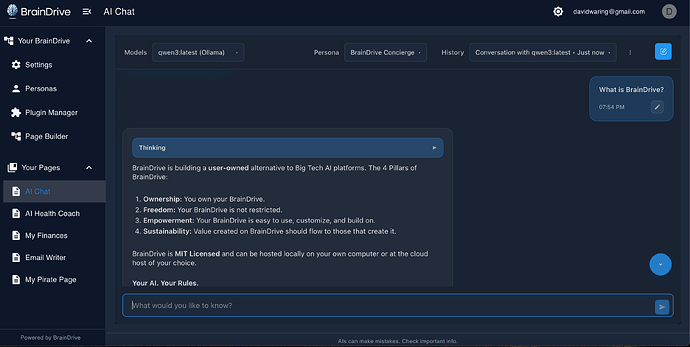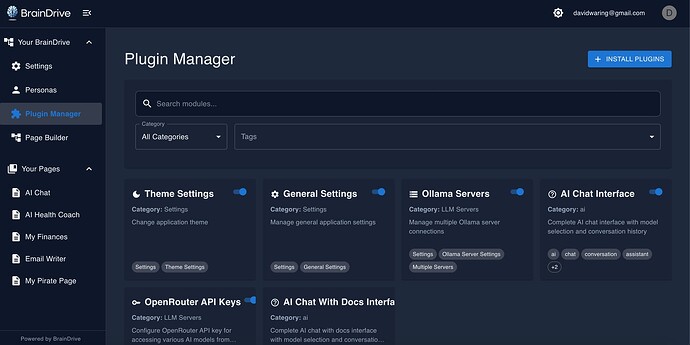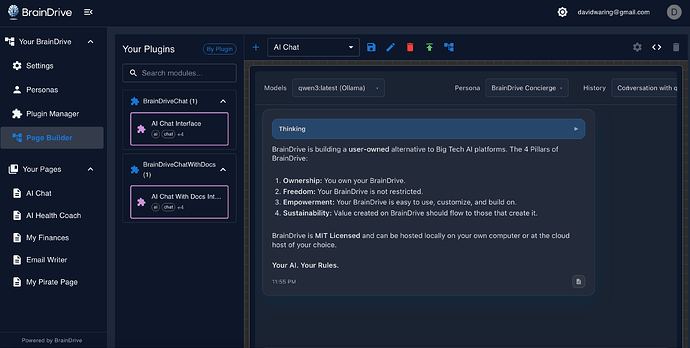Abstract: We propose a user-owned alternative to Big Tech AI systems, built on the pillars of ownership, freedom, empowerment, and sustainability.
An alternative comprised of:
- An open core for interacting with, and building on top of, both open-source and proprietary AI models.
- An open, plugin-based architecture which enables anyone to customize their AI system with plugins, data sources, agents and workflows.
- An open free-market economy, where plugins, datasets, workflows and agents can be traded freely without lock-in from rent seeking, walled garden platforms.
- An open community where AI system owners can join forces to build their AI systems and the future of user-owned AI.
- A sustainable aligned revenue model ensuring long-term ecosystem development without compromising user ownership, freedom, and empowerment.
As AI becomes integral to every aspect of human life, the question of who owns these systems will define our future. Join us on the road away from Big Tech exploitation, and towards individual freedom and empowerment.
1. Introduction
The internet, which began as a decentralizing technology, is now increasingly concentrated in the hands of a few Big Tech companies. These companies are worth trillions, because we live in a knowledge economy, and they control the knowledge.
AI is putting the trend towards Big Tech centralization and extraction on steroids. But it doesn’t have to be this way.
Many of the building blocks of an open, user-owned alternative to Big Tech AI systems already exist. They just haven’t been combined in a manner that makes them a superior alternative.
That’s the goal of BrainDrive and this paper. To provide a concrete vision for an open, user-owned AI alternative to Big Tech’s closed systems, and to introduce BrainDrive, our attempt to execute on this vision.
Open source software is key to this vision. However, as we have seen with the internet, the decentralizing benefits of open source technology will be lost, if power is centralized in other parts of the ecosystem.
This is why we propose a framework for building not only open source software, but an entire user owned AI ecosystem. An open ecosystem that is not just an alternative to Big Tech AI systems for open source enthusiasts, but a better alternative for all.
Here’s how we do it:
2. Open Core
The first component is an open source foundation to build on.
BrainDrive Core is the MIT Licensed front and back end software that powers your AI system.
It’s built using the most popular open source libraries, and designed for your complete ownership, freedom, and control.
With Big Tech AI systems you’re a user. With BrainDrive you’re the owner.
BrainDrive Core includes:
A chat interface for running self and cloud hosted AI models:
A plugin manager to easily search existing, and add new plugins to your BrainDrive:
A page builder to create custom interfaces using your own and other publicly available plugins:
Deploy locally on your own computer or on the cloud host of your choice. No Big Tech lockin.
3. Plugin Based Open Architecture
In order for user-owned AI to win, we need to not just match the features and functionality of Big Tech AI systems, but exceed them.
And this is what BrainDrive’s open, modular, plugin based architecture is designed to enable.
With Big Tech AI systems you’re limited to what they provide you. With BrainDrive, the only limit is your imagination.
Plugins add new features, integrate with external services, and customize your BrainDrive’s user experience so it can be as unique as you are.
As a BrainDrive Owner you can build your own plugins and/or add plugins developed and offered by other BrainDrive Builders and Entrepreneurs.
The system is designed to be:
- User Owned: You own and control your plugins, data, and deployment.
- Permissionless: Anyone can create or use whatever plugins they would like in their BrainDrive.
- Modular: Each plugin is self-contained with its own components and services
- Secure: Plugins operate within a controlled environment with defined permissions
- Composable: Combine and build on existing plugins to build your unique workflows and agents.
Think Wordpress but for AI.
4. Open Free Market Economy
Big Tech companies are not participants in an open, free-market digital economy. They are the owners of closed economies built on their platforms. This is why they continue to grow at astronomical rates, while the rest of the economy stagnates.
And AI is about to make this concentration of power and wealth exponentially worse.
But it doesn’t have to be this way.
It is our digital data, knowledge, and intelligence that power the digital economy. All we have to do is stop giving it away to Big Tech companies, and start keeping it for ourselves.
This is what user owned AI systems like BrainDrive, and the open source AI movement enable us to do.
To take back control of our:
- Data — Our files, messages, and logs.
- Memory — embeddings, vectors, and indexes built from that data.
- Intelligence — The AI models, prompts, tools, and guardrails.
- Agents & Workflows — automations that act using our data and intelligence.
These are the new forms of value in the digital economy. Once we take back control, the free market will allow that value to flow back where it belongs, to the people creating it.
5. Open Community
The user owned AI community is not one place. It’s wherever individuals are connecting to discuss and collaborate on their AI systems, and the future of user owned AI.
The BrainDrive community is our contribution to the broader user owned AI community. It’s where BrainDrive owners, builders, and entrepreneurs connect to build and work on their AI systems and the future of user owned AI.
Key features include:
- Shared Values – A commitment to user-owned AI and the 4 pillars of BrainDrive: ownership, freedom, empowerment, and sustainability.
- Knowledge Sharing – Documentation, tutorials, and best practices
- Collaboration Spaces – Forums, GitHub, and other platforms for connecting with peers.
- Shared Resources – Access to templates, open-source tools, and real-world examples.
- Decentralized – Join an existing community, or create a BrainDrive focused space of your own.
With Big Tech you’re collaborating to build value for their systems. With BrainDrive you’re collaborating to build value for your own.
6. Sustainable, Aligned Ecosystem Funding
Big Tech’s funding model relies on closed ecosystems built on their platforms and controlled by their companies. This strategy has generated multi-trillion dollar valuations and sustained high growth rates, but cracks are beginning to show.
Big Tech platforms that were once open and innovative, have now become closed and stagnant.
This is because builders and entrepreneurs have been burned by Big Tech’s “attract then extract” business model, and are now wary of building on platforms they don’t control.
Smart builders and entrepreneurs no longer want to build their houses on rented land. They want to build on foundations they own and control.
This is exactly what the user-owned AI movement, open-source AI models, and BrainDrive’s open architecture enable: a true free market, where individuals improve their own systems and earn by enhancing other’s.
This open free market approach will create a more powerful economy in the digital world, for the same reasons it does in the offline world - It better aligns incentives.
- Plugin Developers: Earn revenue by solving real problems for BrainDrive Owners
- AI Model Builders: Earn by building custom models for industry specific, and other niche use cases.
- Data Contributors: Monetize valuable datasets and knowledge bases
- Service Providers: Offer specialized AI services, hosting, and support
No Big Tech lockin. Just individuals working to build the future of user owned AI directly with each other, and via open, competitive marketplaces.
Why build value for Big Tech’s extractive platforms, when you can build value for your own platform instead?
7. Sustainable Core Funding Model
For the user-owned AI ecosystem to thrive long-term, we must solve the critical funding challenge that plagues many open-source projects: sustaining the core infrastructure that everyone depends on, but no one wants to pay for directly.
To solve this issue we propose:
- A technical architecture that pushes the majority of the value creation and innovation out of the core, and into the plugins tools and services layers. This allows the free market to fund the majority of ecosystem development as outlined in section 6 of this paper.
- Mission aligned for-profit stewardship of the core.
BrainDrive LLC, led by BrainDrive co-creators Dave Waring and Dave Jones, serves as the mission-aligned steward responsible for:
Initial Ecosystem Development:
- Building out BrainDrive Core
- Solving the chicken-and-egg problem that prevents network effects from forming
- Providing seed funding and resources to bootstrap the ecosystem
- Creating initial plugins and documentation to demonstrate the platform’s potential
Sustainable Core Funding:
- Generating revenue through ecosystem participation rather than platform control
- Maintaining a lean core architecture that keeps funding requirements minimal
- Ensuring continuous development and security updates for BrainDrive Core
In return for stewarding the core infrastructure, BrainDrive LLC receives:
- Exclusive trademark rights to the BrainDrive name and brand
- Default ecosystem links from BrainDrive Core to BrainDrive.ai and community resources (easily removable by users who prefer alternatives).
Outside of these two advantages, BrainDrive LLC participates in the market on merit just like any other contributor.
This hybrid approach combines the stability of stewarded infrastructure with the dynamism of free-market competition.
8. Protecting Against Ecosystem Capture
Big Tech companies build competitive moats on your digital data and knowledge. Everything described in this paper is built to ensure when it comes to your digital data and knowledge, the competitive moat is yours.
This includes:
Open Source Core: MIT license ensures your complete ownership, freedom, and control. Don’t like what we’re doing? Fork and compete.
Modular and Permissionless Architecture: Don’t like what a system component is doing? Swap it out for another, or build your own.
Open Branding: Brand your AI System as you please, no fork necessary. Just don’t pretend to be BrainDrive.
Mission Aligned Leadership: Project co-creators as operational and technical leads.
Mission Aligned Investment: Project co-creator funded. No outside shareholders.
The BrainDrive Ecosystem is built so you can:
- Contribute in ways that best benefit you
- Fork the BrainDrive codebase and create competing platforms
- Copy BrainDrive’s architectural patterns and improve upon them
- Criticize BrainDrive’s approach and build better alternatives
- Use the BrainDrive ecosystem template to launch your own user-owned AI ecosystem
Big Tech locks your digital data and knowledge inside their walls. BrainDrive sets it free.
9. Conclusion
The window for building user-owned alternatives to Big Tech AI systems is narrowing. As AI capabilities advance, so do the network effects that lock users into closed systems.
But this same rapid advancement also creates opportunity. Open-source AI models are reaching parity with proprietary ones. Edge computing is making local AI deployment feasible. And most importantly, builders and entrepreneurs are hungry to build on platforms that they own, control, and benefit from, instead of Big Tech.
The building blocks for user-owned AI already exist. What’s been missing is a framework that combines these elements into a coherent ecosystem that can actually compete with, and ultimately surpass, Big Tech’s offerings.
BrainDrive represents our attempt to provide that framework. Not as the final answer, but as a template that others can contribute to, copy, improve, and adapt. Our vision encompasses:
- Technical excellence through open-source foundations and plugin-based architecture
- Economic alignment where value flows to those who create it rather than distant shareholders
- Community ownership where users control their data, tools, and digital destinies
- Sustainable growth that strengthens rather than compromises user freedom
We invite you to join us on the road away from Big Tech exploitation and towards individual freedom and empowerment.
Your AI. Your Rules.



